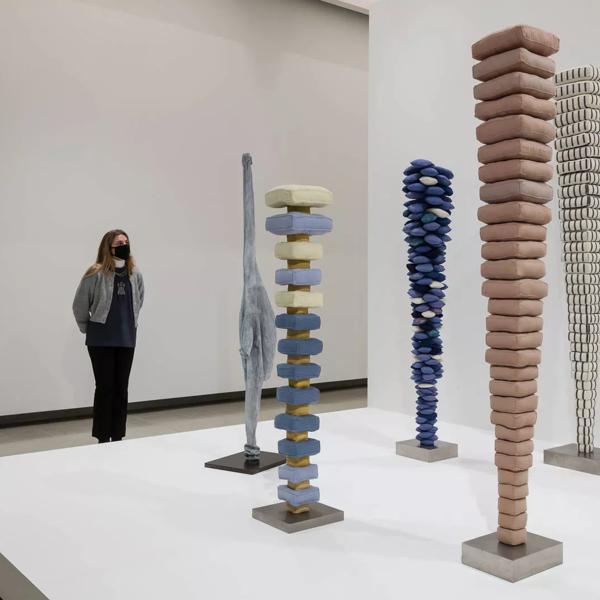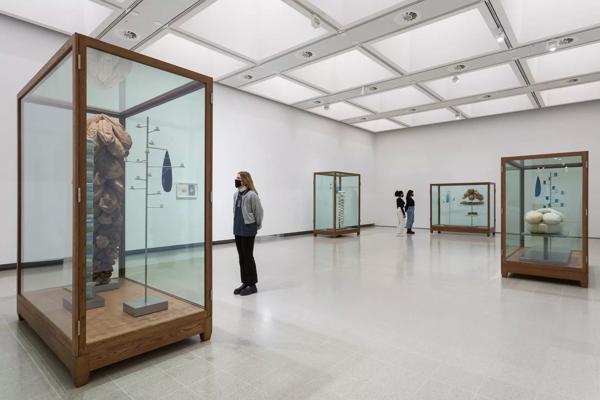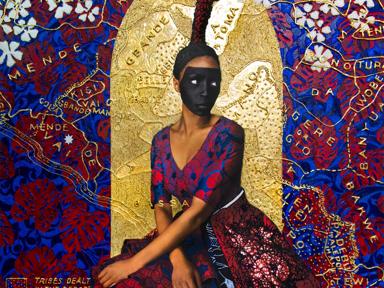Mechanisms of Ambiguity and Sensation: The Late Fabric Sculptures of Louise Bourgeois

Louise Bourgeois: The Woven Child is the first major retrospective of the artist to focus solely on her work with fabrics and textiles.
Writing for the exhibition catalogue, Hayward Gallery Director Ralph Rugoff looks in detail at this chapter of the artist’s career, with a specific interest in the ambiguity and sensation conveyed through Bourgeois’ fabric sculptures. And we’re happy to share an abridged version of that essay with you here.
Mechanisms of Ambiguity and Sensation: The Late Fabric Sculptures of Louise Bourgeois
‘I am not interested in the body; I am interested in the mechanism.’
Over a period beginning in the mid-1990s and continuing up until her death in 2010, Louise Bourgeois created an astonishingly inventive, and often psychologically harrowing, range of sculptures using domestic textiles including clothing, linens, terry cloth towels and tapestry fragments, often sourced from her own household and personal history.
While these late works explored some of the motifs and concerns of her earlier art – sexuality, familial trauma, the ambivalence of human relationships – they also introduced a fuller articulation of the figure and face, as well as an expanded and at times more intimate emotional register, due in part to the personal character and softness of their materials. Primarily focused on the female form, Bourgeois’s panoply of soft bodies and orphaned anatomical parts can be disconcertingly confrontational while also conveying a sharp-edged poignance, especially when invoking abject and distressed states of being.
In a broad sense, these fabric sculptures continued the unswerving exploration of ambiguity that comprised the core aesthetic strategy of the artist’s earlier oeuvre. Bourgeois’s description of a work from the 1960s as being ‘simple in outline but elusive and ambivalent in its references’ aptly applies to most of her late sculpture as well. A carnivalesque vein that veers from the macabre to the fantastic also weaves in and out of these late sculptures; amidst notes of loss and desolation, one encounters flashes of mordant humour.

As early as the 1960s, Bourgeois had made a number of sculptures, such as Fillette or Janus Fleuri (both 1968), that conflate characteristics of male and female genitalia and body parts, presenting ambiguous compounded forms that confound facile identification and resist conventional delineations of gender boundaries. Some of Bourgeois’s later fabric sculptures deploy a similar hybridising strategy but arguably in a more extensive and radical manner.
Cell XXI (Portrait) (2000) features a tangled construction of pink and white fabric that can not only be alternately read as referencing bits of male and female genitalia, but that also possibly depicts a pair of breasts as well as upside down facial features and abstract topographies. The ambiguity in a work such as this goes beyond a simple combining of ‘opposites’ and instead engages the viewer in an experience of slipping from one (often unrelated) association to another in an unresolvable process of interpretation. Bourgeois manages this semantic derailing, in part at least, by de-emphasising and scrambling visual definition while activating associations of tactile encounters through her use of soft, ‘huggable’ materials. This kind of ‘portrait’ appeals less to our eyes than to memories related to our most intimate sense – touch. The categorical fuzziness engineered by these soft sculptures, in other words, is facilitated by their fuzzy surfaces.
Perhaps the most humble of all Bourgeois’s body-part sculptures, Femme (2005) seems to hover around an aesthetic degree zero. Crudely referencing a female torso, it comprises a rectangular cushion-like form with a pair of round lumpy protuberances stitched onto its top at one end and a (presumably vaginal) opening sewn into the side at its opposite end. Along with its threadbare tapestry fabric and rudimentary stitching, the sculpture’s composition and facture are so strikingly reductive that the work seems to oscillate between organic, bodily reference and geometric or architectural form. Creating works that precariously straddle the boundary between art and non-art is an approach that some of Bourgeois’s influential 20th century colleagues such as Eva Hesse and Marcel Duchamp also explored, often as a means of underscoring the arbitrariness of the conventions by which art is defined at a particular moment in time.
In Bourgeois’s fabric sculpture, however, it is pointedly a representation of female form that is put into question through this threshold aesthetic, so that these bodies seem at once to mockingly summon, and to short-circuit, a categorising and objectifying gaze while conveying, through a kind of visual analogy, sensations related to dejection and alienation.

In 1998, at the age of eighty-six, Bourgeois began making a series of fabric heads that became a key focus of her sculptural output over much of the following decade. Considering the many head-less figures that appear throughout her oeuvre and given the increased emphasis in her fabric sculptures on bodily fragments, this might initially have seemed like a surprising development. In sculpture, after all, a head almost inevitably stands for a whole person; more than any other part of the body, we regard the head – and the face in particular – as the principal locus of the self, the screen on which our inner emotions and character are made visible. With this late series Bourgeois produced some of the most arresting, emotionally layered and formally ingenious sculptures of heads produced in the past hundred years.
Bourgeois’s fabric heads are not so much portraits of particular individuals as evocations of diverse, and often ambivalent, mental and emotional states. For the most part, they have no clearly identifiable gender; nevertheless, each one is highly distinctive, differentiated by the type of fabric utilised and how it is cut and sewn, as well as by the varying specificity of their facial features. Pierre (1998) was named after Bourgeois’s younger brother, and so may be considered the one exception that depicts, at least symbolically, an actual person (writer and curator Robert Storr has described this sculpture as ‘an anguished and anguishing posthumous portrait of [Bourgeois’s] institutionalised brother.’) Composed of irregularly cut sections of pink jersey joined together by clumsy stitching, and bearing asymmetrical features – a single ear, a gaping mouth, one eye closed and the other open – Pierre is a portrait of off-kilter pieces. Lying on its side as though its soft, battered-looking material was incapable of maintaining upright posture, this sculptural head summons the spectre of a ‘lost’ soul, someone adrift and vulnerable.
This kind of ‘portrait’ [Cell XXI (Portrait) (2000) ] appeals less to our eyes than to memories related to our most intimate sense – touch.’
In some of the head sculptures, the borders of recognisable features are redrawn, or drawn over, through the use of line and colour or through tactile surface textures that effectively corporealise the face. In this way, a number of Bourgeois’s heads take on, often with carnivalesque flair, the politics of the face as sovereign signifier of a subjectivity cleanly divorced from the rest of bodily experience. Consider Untitled (2002), a head composed of fragments of needlepoint embroidery. Ornamental geometries sprawl across its features like an elaborate and intricate tattoo, derailing our vision into a scrambled pictorial landscape in which a human face seems to alternately appear and vanish. Hinting at a multidimensional topology of identity, this bodiless head manages to evince a polymorphous corporeality.
In another untitled sculpture made that same year, Bourgeois created a kind of eerie double portrait: on the side of the head, she placed a section of tapestry that depicts an oddly misshapen visage, which appears in this context as if a shadowy second self. Untitled (2009), a sculpture featuring four faces, each looking in a different direction, further expands on this motif of multiple identities, while also recalling the artist’s many drawings of Janus-like faces. Three faces, each bearing distinctly different expressions, are rendered in a grey textile; in contrast, the fourth is graphically divided by bold blue and red lines that swerve like unleashed nerves across a quilted expanse of mesh-patterned fabric. For all its disorienting strangeness, looking at this expanded landscape of a head can seem like an uncannily familiar experience as it aptly analogises ambivalent and contradictory mental states well known to us all.

Artist Adrian Piper has extolled Bourgeois’s art for reminding us ‘of the chasm that separates the corporeal and infantile beings that we are from the cerebral, self-governing agents we tell ourselves we are.’ This remark seems particularly applicable to Bourgeois’s fabric sculptures: with their de-sublimated depictions of figures and faces, these works confront us with intimations of a fluid, multiform subjectivity that calls into question our socially sanctioned, coherent self-images. One of art’s great and enduring roles, as Piper’s comment implies, is to help us to see past our relentless efforts at self-forgetting; Bourgeois’s soft sculptures manage to enact this role with a bracingly visceral and multi levelled resonance that few artworks in any medium ever manage to achieve.
More than one writer has described Bourgeois’s turn to working with fabric late in her life as a return to the material of her childhood, when she worked in the atelier of her family’s tapestry restoration business. Yet the character of this ‘return’ was hardly a straightforward revisiting; to some extent it recalls Karl Marx’s aphorism that history repeats itself, first as tragedy and secondly as farce. Bourgeois’s fabric sculptures, after all, suggest a complete inversion or caricature of the activity that defined the family workshop of her youth. Rather than repairing textiles in order to make them appear intact again, the artist cut up remnants of tapestries and clothing and refashioned them into patchwork constructions, some of which are stitched together in a deliberately clumsy manner that seems like a parody of conventional sewing.
‘A number of Bourgeois’s heads take on, often with carnivalesque flair, the politics of the face as sovereign signifier of a subjectivity cleanly divorced from the rest of bodily experience.’
But perhaps in one respect, inasmuch as her childhood job in the family atelier was to draw in the body parts missing from damaged tapestries – mostly absent feet – Bourgeois’s late work did indeed constitute a return of sorts to this early activity with its focus on fragments. And though most of her fabric sculptures may fail to correspond to our usual sense of repair as mending, they nevertheless comprise a mode of restoration: directing us away from idealised conceptions of pristine wholeness, they unflinchingly restore our sense of the motley and multifarious character of our psychic life. In the process they remind us that there are no ultimate truths in art – only metamorphoses, and the various dislocations, repositionings and replacements with which they are engineered.
In turning the notion of a restoration workshop on its head, Bourgeois in her soft sculptures found ways to open up the possibilities of plastic ambiguity – and the attendant slippages of signification that it enables – to a degree perhaps unmatched by any of her previous sculptures in more traditional media. In what must surely count as one of the greatest late-career chapters in the history of art, she forged with fabric a final body of work in which lifelong concerns – with destabilising boundaries, ambiguous sexualities, sliding registers of meaning and non-binary identities – were revisited in newly provocative and profoundly enlivening ways. A decade after her death, these works continue to challenge us with questions that seem more compelling and urgent than ever.
The complete version of this essay by Ralph Rugoff can be read in the exhibition catalogue for Louise Bourgeois: The Woven Child. The catalogue can now be purchased from the Southbank Centre Shop
The first major retrospective of the artist to focus on her later fabric works, Louise Bourgeois: The Woven Child was at Hayward Gallery 9 February – 15 May 2022.

From internationally acclaimed artists at Hayward Gallery, to pop-up installations, showcases and immersive experiences, enjoy an engaging and inspiring array of art and exhibitions with us.